Richard Conniff's Blog, page 115
November 10, 2010
Big Cojones
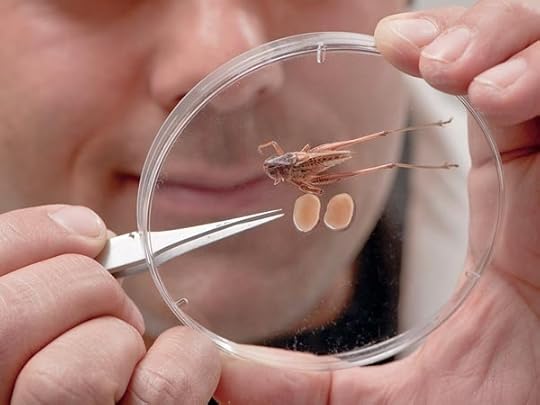
A bush cricket and its testicles (Photograph courtesy Richard Richards, University of Derby)
Here's a report from the French Tribune about a new study on who's got the biggest cojones, and just to help you with the math, it's like a 180-pound man having 25-pound testicles:
A team of Scientists has found that a bushcricket species has the largest known testicles of any creature in relation to its body mass.
The scientists at the universities of Cambridge and Derby measured the tuberous bush cricket, Platycleis affinis and found that its testicles accounted for 14% of the insect's body weight.
Karim Vahed of the University of Derby and his colleagues measured the testicle size of 21 species of bushcrickets as part of the study of the evolutionary consequences of the insects' sexual habits.
The scientists also studied the mating strategies of the insects and found that they release only small amounts of sperm at each mating. This indicates that large testicles are for mating with many females and not for producing more sperms.
"Males with bigger testicles are actually producing smaller amounts of ejaculate. This very much favours the alternative hypothesis: that it's about the number of different females the male can fertilise, rather than getting a greater success per female." said Dr Vahed.








October 28, 2010
The Scariest Animal in the World?
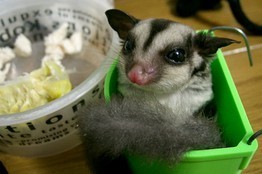 Here's the candidate, nominated by a group called EcoHealth Alliance, as reported by Katherine Hobson in the Wall Street Journal:
Here's the candidate, nominated by a group called EcoHealth Alliance, as reported by Katherine Hobson in the Wall Street Journal:
What's the scariest animal on the planet?
For Peter Daszak, a disease ecologist and president of EcoHealth Alliance, it's not a great white shark or a tiger or even the disease-spreading mosquito.
It's this cutie over there on the right that keeps Daszak awake at night. That's a sugar glider. They live in the tropics, which, as the regions with the highest biodiversity, also have the potential to harbor the most emerging pathogens.
But animal pathogens can change and jump to humans, as SARS and HIV demonstrate. In fact, about 75% of emerging infectious diseases currently affecting people began in animals. "A chimpanzee virus killed 25 million people – that's why I'm here," Daszak told the crowd at TEDMED, referring, of course, to HIV. Daszak's research focuses on identifying new pathogens, preventing their spread and "developing tools to deal with them if they emerge," he says.
And because he says new pathogens emerge in "stressed landscapes," when human activities encroach on wildlife-rich areas, his group emphasizes conservation science as a way to both preserve biodiversity and protect people. Pathogens love it when organisms — of the same or different species — crowd together, giving them a bigger Petri dish in which to frolic.
But back to the sugar glider. The marsupial's very cuteness makes it appealing to people here who find, say, guinea pigs or gerbils too mundane.
"We bring thousands of pets into the U.S. right from these hot spots," Daszak said. "What better way is there for a pathogen to spread?"








October 27, 2010
A New Breed of Grave Robber
A lot of people lately have been quoting German philosopher Immanuel Kant to the effect that "Perpetual peace is only found in the graveyard." I suspect he actually said something a lot less appetizing (and more Germanic), about how a war of extermination "would permit perpetual peace only in the vast burial ground of the human race."
But this is a roundabout way of saying that graveyards in the Arctic Circle are apparently not so peaceful as reputed, now that a ghoulish new breed of grave robbers has begun treating them as refigerators for fresh meat. Here's the report from the UK Guardian:
From a distance it resembled a rather large man in a fur coat, leaning tenderly over the grave of a loved one. But when the two women in the Russian village of Vezhnya Tchova came closer they realised there was a bear in the cemetery eating a body.
Russian bears have grown so desperate after a scorching summer they have started digging up and eating corpses in municipal cemetries, alarmed officials said today. Bears' traditional food – mushrooms, berries and the odd frog – has disappeared, they added.
The Vezhnya Tchova incident took place on Saturday in the northern republic of Komi, near the Arctic Circle. The shocked women cried in panic, frightening the bear back into the woods, before they discovered a ghoulish scene with the clothes of the bear's already-dead victim chucked over adjacent tombstones, the Russian newspaper Moskovsky Komsomelets reported.
Local people said that bears had resorted to scavenging in towns and villages – rummaging through bins, stealing garden carrots and raiding tips. A young man had been mauled in the centre of Syktyvkar, Komi's capital. "They are really hungry this year. It's a big problem. Many of them are not going to survive," said Simion Razmislov, the vice-president of Komi's hunting and fishing society.
World Wildlife Fund Russia said there had been a similar case two years ago in the town of Kandalaksha, in the northern Karelia republic. "You have to remember that bears are natural scavengers. In the US and Canada you can't leave any food in tents in national parks," said Masha Vorontsova, Director of the International Fund for Animal Welfare (IFAW) in Russia.
"In Karelia one bear learned how to do it [open a coffin]. He then taught the others," she added, suggesting: "They are pretty quick learners."
The only way to get rid of the bears would be to frighten them with something noisy like a firework or shoot them, she said.
According to Vorontsova, the omnivorous bears had "plenty to eat" this autumn, with foods such as fish and ants at normal levels. The bears raided graveyards because they offered a supply of easy food, she said, a bit like a giant refrigerator. "The story is horrible. Nobody wants to think about having a much loved member of their family eaten by a bear."
The bear population in Russia is relatively stable with numbers between 120,000 and 140,000. The biggest threat isn't starvation but hunting – with VIP sportsmen and wealthy gun enthusiasts wiping out most of the large male bears in Kamchatka, in Russia's Far East. Chinese poachers have killed many black bears near the border, selling their claws and other parts in markets.
The Russian government is drafting legislation to ban the killing of bears during the winter breeding season.








October 22, 2010
Kitchen Companion? Going the Distance for an Endangered Spider

Fen Raft spider, photo by Tommy Bostrom
LONDON (AFP) – Thousands of baby spiders bred in a kitchen will be released into the countryside this week in a bid to revive an endangered species, a government biodiversity agency said Friday.
Some 3,000 baby fen raft spiders reared by ecologist Helen Smith will be let loose in the Castle Marshes nature reserve in Suffolk, according to Natural England.
The fen raft spider is classed as endangered in Britain and can be found at only two sites in England and one in Wales. The spiders are large — the body of an an adult can be as long as 23 millimetres — with distinctive white, cream or yellow stripes across the abdomen.
The baby arachnids were reared in individual laboratory test tubes to prevent them from attacking each other, and were hand-fed with fruit flies.
Smith said raising the creatures was an "exhausting" job. "At one stage I was up until 2:00 am, seven days a week, feeding flies to hungry young spiders in my kitchen," she said. "I'm excited and relieved to see them making their own way in the world — and I can finally have my kitchen back."
***
N.B. Unfortuately, this article doesn't name the species, but I am assuming it's Dolomedes plantarius. Here's a link to the Guardian's story, also with no species name.








October 21, 2010
Hanging on By Less Than a Thread
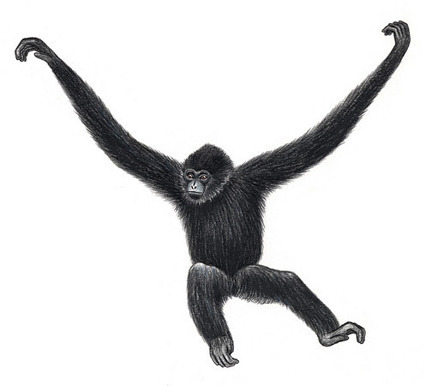
Cao Vit or eastern black crested gibbon (Nomascus nasutus), China and Vietnam. Illustration by Stephen D. Nash.
Nice editorial in today's Guardian (UK) about the loss of species and how it threatens our own survival. Here's an excerpt
The auguries are not good. A few weeks ago, the International Union for the Conservation of Nature confirmed the capture and subsequent death of a rare antelope from the mountains of Vietnam and Laos. This animal – Pseudoryx nghetinhensis – was discovered only in 1992 and last spotted by an automatic camera in 1999. It has, however, never been seen alive by a working zoologist. So, it has been named and pronounced critically endangered by researchers who know almost nothing about it. Researchers know a little more about the crested gibbons that live in south-east Asia. They know that there are seven species in the genus, and that one is now down to 100 individuals, and another to about 20. These species have just been declared the world's rarest apes.
The story is no happier closer to home. In March IUCN confirmed that 9% of Europe's 435 butterfly species and 11% of the saproxylic beetles that live in rotting wood are threatened with extinction, for the same reason that the crested gibbons could swing through the trees into oblivion: human pressure on habitat. Likewise, last year more than 1,200 bird species were classified by IUCN as threatened with extinction. Does it matter? Yes: civilisation is built on life's diversity. We survive only on the bounty of the living world and the rocks beneath, and even coal and oil were once living things. Biodiversity delivers fuel, fibres, fabrics, all food and most medicines: it also hums away unobserved, pollinating crops and recycling the planet's air, water and nutrients. Without the saproxylic beetles, the forests would be full of dead trees, and soon there would be no forests. So conservation is quite literally vital.








October 19, 2010
I'm Ready for my Close-up Now, Mr. Demille.
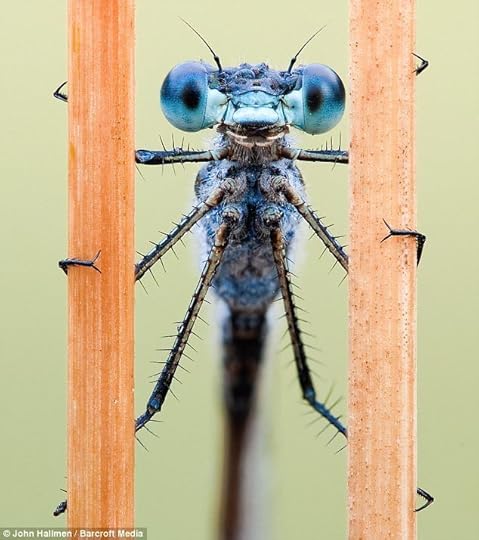 Today's (UK) Mail includes some lovely insect photography by John Halman, and they're worth a look for a reminder that insects can be both extraordinarily beautiful and of course also a little creepy.
Today's (UK) Mail includes some lovely insect photography by John Halman, and they're worth a look for a reminder that insects can be both extraordinarily beautiful and of course also a little creepy.








Three-Toed Sloths Saved From Excess Necking
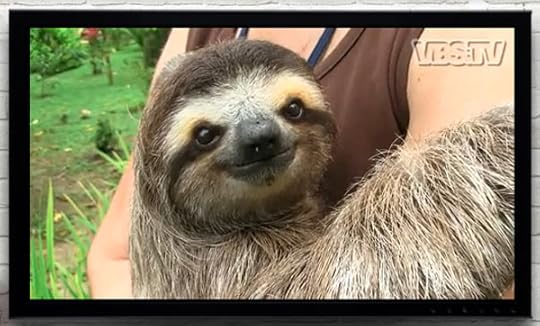 One of the great mysteries in mammalogy appears to be solved, and it gives me an excuse to republish this adorable photo. Here's part of the press release from the University of Cambridge:
One of the great mysteries in mammalogy appears to be solved, and it gives me an excuse to republish this adorable photo. Here's part of the press release from the University of Cambridge:
By examining the development of bones in the vertebral column, limbs, and ribcage, scientists at the University of Cambridge have discovered how sloths evolved their unique neck skeleton.
From mice to giraffes, mammals are remarkable in that all but a handful of their 5000 species have exactly seven vertebrae in the neck. Among the few that deviate from this number are three-toed sloths, which may have up to ten ribless vertebrae in the neck.
Traditionally, vertebrae above the shoulders that lack ribs are known as cervical or neck vertebrae. Animals such as birds and lizards show great variety in the number of vertebrae in their neck. For example, a swan may have twice as many as a songbird.Mammals, on the other hand, are much more conservative. A giraffe has the same number of neck vertebrae as a human, mouse, elephant, or armadillo; all have exactly seven.
To find out why the three-toed sloths was an exception, zoologist Robert Asher and his co-authors studied its embryological development. They found that in other mammals, the top vertebrae of the ribcage develop first, followed by the bottom vertebrae of the neck. But the sloth develops the bottom vertebrae of the neck first. And that is because they are actually rib vertebrae, minus the ribs. That is, the sloth is not so odd after all, at least in this regard, and conforms to the larger pattern of mammalian developed. The press release continues.:

Sloth skeleton with "neck" in redTo find out why the three-toed sloths was an exception, zoologist Robert Asher and his co-authors studied its embryological development. They found that in other mammals, the top vertebrae of the ribcage develop first, followed by the bottom vertebrae of the neck. But the sloth develops the bottom vertebrae of the neck first. And that, stupid, is because they are actually rib vertebrae, minus the ribs. That is, the sloth is not so odd after all, at least in this regard, and conforms to the larger pattern of mammalian developed. The press release continues.
All mammals, including sloths, show early development of the body of the eighth vertebra down from the head, whether or not it is part of the neck.In other words, the bottom neck vertebrae of sloths show a similar sequence of development as the top ribcage vertebrae of other mammals, both of which start at eight vertebrae down from the head. This shows that the bottom "neck" vertebrae of sloths are developmentally the same as ribcage vertebrae of other mammals, but lack ribs.
Dr Robert Asher, of the Department of Zoology at the University of Cambridge, said: "The remarkable conservatism of the mammalian neck is apparent even in those few species that superficially seem to be exceptions, like sloths. Even though they've got eight to ten ribless vertebrae above the shoulders, unlike the seven of giraffes, humans, and nearly every other species of mammal, those extra few are actually ribcage vertebrae masquerading as neck vertebrae."
Shoulders, pelvis, and ribcage are linked to one another in three-toed sloths, and have simply "shifted down the vertebral column to make the neck longer," according to the press release.
The press release does not suggest why the sloth might have developed this way, and unfortunately I am unable to access the original publication at the moment. But the traditional interpretation of the three-toed sloth's excess neckiness is that it evolved to enable the sloth to reach around and eat the available leaves as it hangs from the branch of a tree. The new study does not appear to change that interpretation.
You can read more about sloths in my book Every Creeping Thing: True Tales of Faintly Repulsive Wildlife.
The paper 'Skeletal development in sloths and the evolution of mammalian vertebral patterning' by Lionel Hautier, Vera Weisbecker, Marcelo R. Sánchez-Villagra, Anjali Goswami, and Robert J. Asher appears the 18 October 2010 edition of the Proceedings of the National Academy of Sciences.








October 15, 2010
The Species Seekers Quiz: Degenerate Americans
 Who proposed the "theory of American degeneracy?"
Who proposed the "theory of American degeneracy?"
1. Charles Willson Peale, in a fit of anger at his children
2. Georges-Louis Leclerc, Comte de Buffon, after meeting quarrelsome U.S.diplomat John Adams.
3. King George III (or his adviser the devious Lord Bute)
4. The great comparative anatomist Georges Cuvier
And the answer is
 Georges-Louis Leclerc, Comte de Buffon
Georges-Louis Leclerc, Comte de Buffon
Buffon proposed in 1749 that "a niggardly sky and unprolific land" caused species in the Americas, including humans, to become puny and degenerate. Thomas Jefferson was obsessed with discrediting this misguided idea. He constructed elaborate tables of American species, setting "the heaviest weights of our Animals…from the mouse to the mammoth" against diminutive Old World counterparts. When he sailed in 1784 to become American trade minister and then ambassador to Paris, Jefferson carried "an uncommonly large panther skin" in his luggage with the idea of delivering to Buffon in person. Later he followed up with a moose. As President of the United States, Jefferson sent the Lewis and Clarke expedition into the American West partly in the hope of finding a living American mammoth as the crowning argument against Buffon's "theory of American degeneracy."








October 13, 2010
The Species Seekers Quiz: Inside Jefferson's White House
 What did Thomas Jefferson keep in the East Room of the White House?
What did Thomas Jefferson keep in the East Room of the White House?
1. A collection of mastodon bones.
2. Silver crafted by Paul Revere.
3. The largest library of natural history books in North America.
4. A conference table made of petrified wood.
And the answer is
A collection of mastodon bones.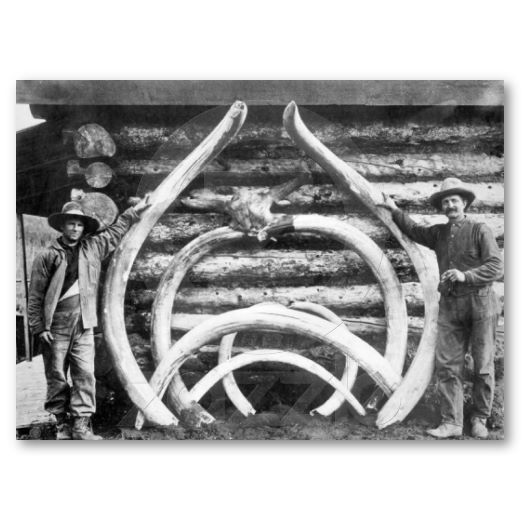
Jefferson sent off a letter, carried by Daniel Boone, to his friend George Rogers Clark, commander of the Army of the West, asking him to collect specimens from Big Bone Lick, a sulphur-smelling patch of marsh near the Ohio River in Kentucky. The first —and only successful— shipment from Clark arrived at the White House in March of 1808. Jefferson had these fossils spread out in a large otherwise unused room that later would become known as the East Room. (It was a step up from John and Abigail Adams, who had hung their laundry there.)








October 11, 2010
The Species Seekers Quiz: A Movement to Make Museums New
What spurred the "new museum" movement?
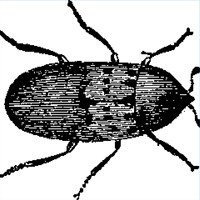 1. Generous donations from American railroad magnates
1. Generous donations from American railroad magnates
2. The British urge to out-compete the museums of rival nations
3. Dermestid beetles, which ruined many old museums
4. Advances in taxidermy
And the answer is
During the second half of the 19th century, taxidermists had rapidly become more skillful and they now wanted not merely to educate but to excite the public with dioramas rendering dramatic scenes from the wild. In 1869, the French naturalist and specimen dealer Jules Verreaux depicted a lion rearing up to claw an Arab courier down from the back of a camel, an exhibit that drew crowds to the American Museum of Natural History in New York.
A few years later, the National Museum of Natural History in Washington, D.C., displayed "Fight in the Tree-Tops," a scene of "immense and hideously ugly male orang utans fighting furiously," with blood gushing from the wound where one sank his fangs into the other. Critics worried about a certain lack of scientific probity. But a defender responded, "If you cannot interest the visitor you cannot instruct him; if he does not care to know what an animal is, or what an object is used for, he will not read the label."
Recreating a moment from nature in a good diorama required fresh skins of the featured species, and also all the attendant details of its habitat, down to rocks and grass. So instead of simply buying specimens, or accepting them as gifts, museum curators and taxidermists now had to go out and become field collectors themselves. It was the beginning of the "new museum movement," and the comprehensive survey collections they brought back served the needs of showmen and scientists alike.












